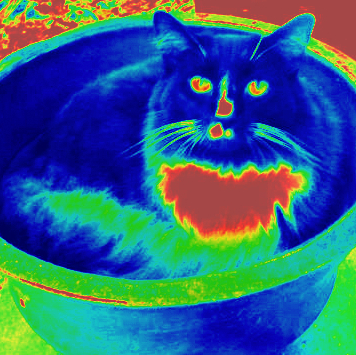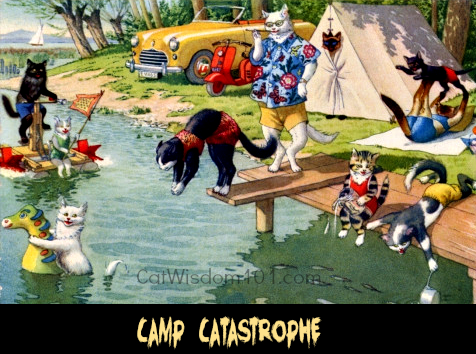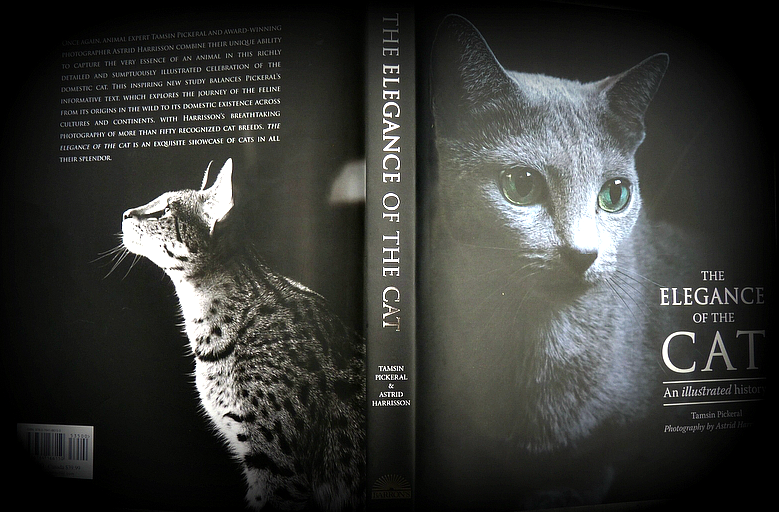Vet 101: Q & A: Feline Hot Spots
This week’s reader Q & A by vet Dr. Rich Goldstein is about hot spots and no, we don’t mean Miami, Maui or Mexico.

Question: My seven-year-old male Persian has a small oozing hotspot on the back of his head; I suspect from a nick the last time he was groomed. Can you recommend any natural treatments? He’s had them before in the summer but never in the winter. What else might have caused it? He was wearing a new collar but I removed it. Thanks for your help!
Answer: It used to be that when you used the term “hot spot”, everyone knew you were talking about a sore on your dog or cat. Just for “fun”, I googled “hot spot” , and was well into page 4 before the word “sore” even appeared. My, how times have changed! Hot spots in cats may not be as interesting as the “local hot spot”, or a “volcanic hot spot”, or a Starbucks wifi hot spot, but they can certainly be more important!
“Hot spots”, also known as “acute moist dermatitis”, are reddened, moist, highly irritated skin lesions. They are usually itchy, and can progress very rapidly to become painful and infected. Many causes can contribute to the formation of a hot spot, including allergic reactions, insect or flea or animal bites, ear infections or ear mites, fungal infections (ringworm), skin masses, stress or boredom, and “grooming accidents.”
- Once a hot spot is detected, it’s important to jump on it early so that it doesn’t progress to a painful, infected mess.
- Here are a few tips:
- Clean the affected area with a non-irritating disinfecting solution. Notice how I said, “non-irritating.” That means no alcohol or hydrogen peroxide. I know, Grandma always said, “just put a little peroxide on it”. But that’s not always the best thing to use. Ever notice what happens when you put peroxide on a wound? It bubbles! Those bubbles can cause damage to the healthy skin and underlying tissue. And alcohol stings! Better to use something like sterile saline, or a very dilute solution of betadine (diluted to the color of weak tea), which are readily available at your local pharmacy.
- If possible, clip away some of the surrounding hair to help keep the wound clean. A grooming clipper works best. Sometimes using just a pair of blunt scissors to shorten some of the surrounding hair will be enough to help. It goes without saying that extreme caution needs to be exercised so that you don’cut the skin, especially if your kitty gets scared or the hair is matted.
The use of topical treatments in cats can be tricky. Some cats that are fastidious groomers will lick or clean off topical creams and ointments, many of which can be toxic. This toxic list can include not only medications, but homeopathic and natural remedies as well. Some topical treatments can also cause skin irritation.
In addition to peroxide and alcohol, here are some topicals to avoid in cats:
o Zinc oxide (Desitin, and other skin protectants) – can cause vomiting and diarrhea if ingested
o Cortisone creams – can cause vomiting, diarrhea, and increased drinking and urination
o Antibiotic Ointments (Neosporin, Bacitracin) – can cause vomiting, diarrhea, abdominal pain,
o Tea Tree Oil (Melaleuca) – can cause weakness, muscle tremors, depression, balance loss
o Salicylate-containing creams (in the aspirin family) – can cause depression, vomiting, diarrhea, stomach ulcers
o Any product that says “harmful if ingested” or “may cause skin irritation”.
- One topical product that is reported to be non-toxic and non-irritating is Vetericyn. This product contains very dilute amounts of compounds found in the bleach family (I know I don’t have to say it, but I will: DO NOT — — — USE BLEACH ON YOUR CAT!). It has antibacterial, antiviral and antifungal properties, and can reduce inflammation, pain and itching. (Domino will tell you it works like a charm!). It is available online and in some pet shops. Look for potential underlying causes of a hot spot, including fleas and ear infections, which may require additional treatment.
- Look for potential underlying causes of a hot spot, including fleas and ear infections, which may require additional treatment.
If the wound is deep, infected, not responding to your first aid treatment, or if you are at all unsure what happened, it’s best to have your vet take a look. Sometimes “simple” wounds are not as “simple” as they appear.
Now that your cat’s hot spot is under control, you can head out to your local hot spot, which can be found using your wifi hot spot. Good luck!
Editor’s Note: We have had excellent results with Vetericyn.




21 Comments
Kaye
Thank you, that is very helpful.
Kelly Borts
After I use the Vetricyn do you wrap the hot spot? This is the 1st time I have had to do this?
Koryne rudolph
Hello.
Recently me and my family relocated, including our cat. We lived in boise idaho and moved to conneticut. I was about a month after we got here i noticed that my cats dander provlem was not a problem anymore but then she got attacked by fleas now i feel like that has developed into hotspots. Is there anything i can so do for her at home?
nadbugs
Ah, Layla, found it. Getting Vetericyn.
Maggie
I always thought it would be a good idea to have a cat medicine chest but didn’t know what to put in it. Thank you.
Texas, a cat in New York
My human… when she saw the title she thought: Ladycats have hot flashes too?! Silly human!
As always, very interesting and to be bookmarked. (and my human learned a new expression too)
Thank you =^.^=
Purrs
boomermuse
Texas, your mom is funny. Purrs to the whole gang!
Connie Marie
Glad to know about Neosporin, my local vet had Ok’d it. No more.
Never used peroxide on my cats just my self. I had read in an older book about Betadine iodine. Works on bacterial and fungal infections. Will dilute now.
Vetericyn I will now look for and use it. Thanks for great advice.
Layla, how did you get the picture? It reminds me of a negative turned inside out.
boomermuse
We swear by Vetericyn around here. Image is reversed and played with.
Anonymous
I like the picture. Do you get the Hotspot formula then? There is also a feline wound and infection healer.
I’ll be glad to have it on hand.
Connie
boomermuse
We always have Vetricyn on hand. None of our cats have had hotspots but various abrasions, bites, wounds over the years.
The Musings Of A Crazy Cat Lady
I thought dogs got hot spots and not cats. Thank you for this very helpful information.
Katie and Coccolino the mini pig
This is a very interesting post for us since our cat just had his first hot spot recently. We took him right to the doctor and thankfully it’s getting better. I didn’t know anything about hot spots before though so it’s great to read this.
Skeeter and Izzy
As always great info! Thanks! Luv Skeeter and Izzy >^..^<
The Island Cats
Good information. Interestingly, a long time ago, Wally had his tail slammed in the door. OUCH! Painful, I know. But he only got a small gash on his tail. I took him to the vet and she cut away the fur and cleaned it well. She told me to use a little neosporin on it to keep it from getting infected. When I told her I didn’t have any, she gave me (or rather sold me) a tube of some veterinary antiseptic cream. But here I see you recommend not using neosporin.
Island Cats’ mom
boomermuse
We find Vetricyn very effective, easy to use and it contains no mineral oil lie Neosporin.
meowmeowmans
Such helpful information. Fortunately, our boys haven’t had any hot spots, but now we know what to do if they get them! 🙂
da tabbies o trout towne
thanx domino for de add vise…eye haza tendency ta get hot spots in de summer; for yeers no one haz been abe bull ta come up with a treet mint; me appreciates heerin bout de vetericyn…hope everee one haza grate day
butter lover boomer o cat N crew
Kathryn
Very good to know. If Cheddar or Mao get one, I’ll go to a vet so the vet can put a collar on whichever cat of ours needs help and so he/she can prescribe the right ointment. At least, with a collar, neither of our boys will be able to lick off the ointment.
Because they would.
Cherry City Kitties
Thank you Dr. Goldstein, we always tell our Momma to “file away the information” just in case we need it. We’re pretty lucky, but you never know!
Harry, Dexter and Tipp
Brian
WOW was that some useful info and we sure didn’t know that about peroxide! Thanks!